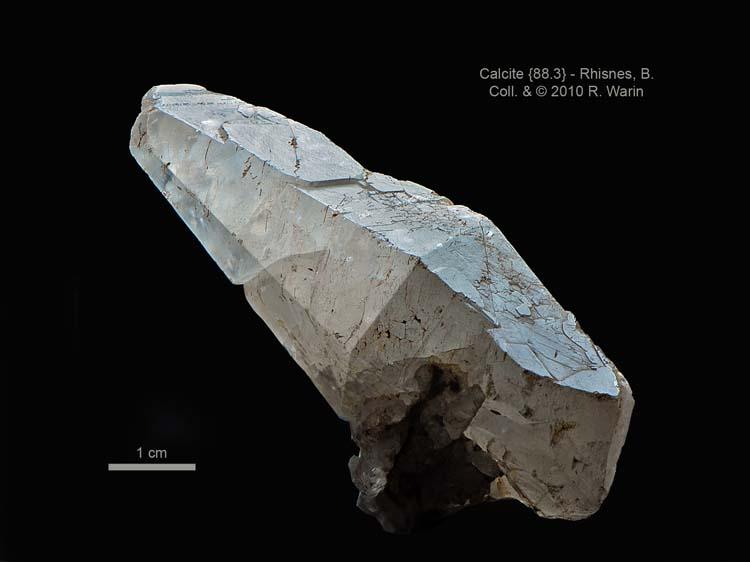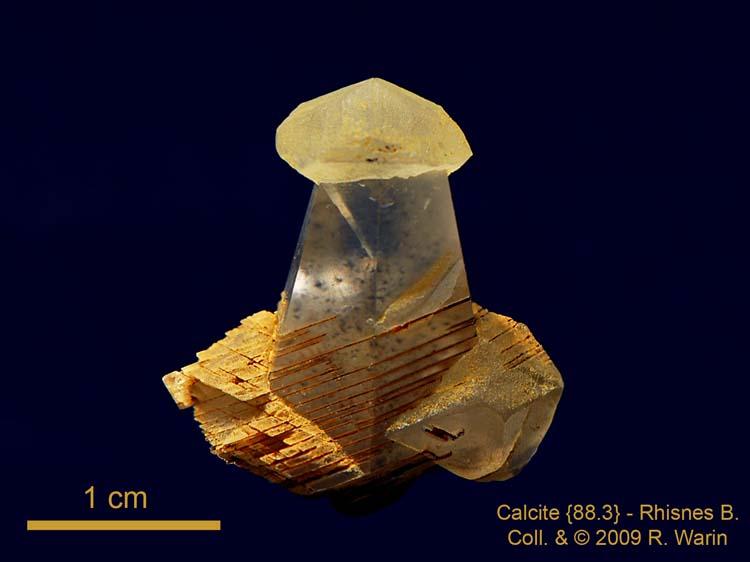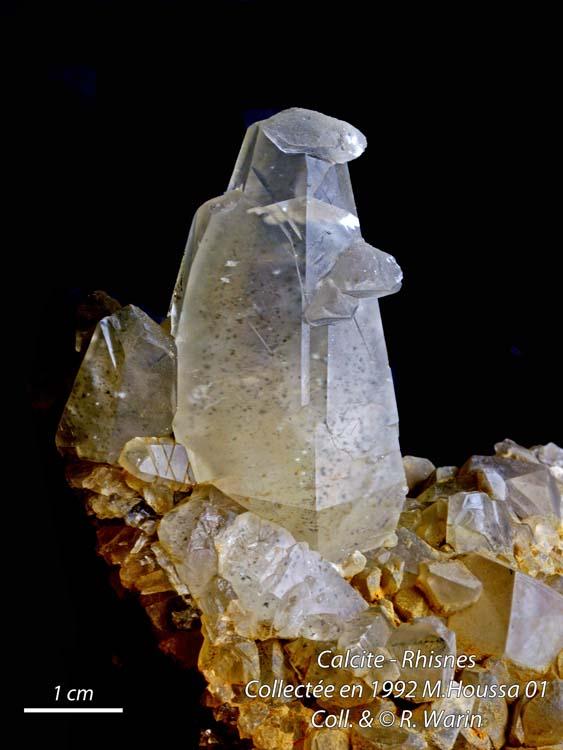| View previous topic :: View next topic |
| Author |
Message |
Roger Warin

Joined: 23 Jan 2013
Posts: 1246



|
 Posted: Feb 18, 2013 17:40 Post subject: Hexagonal dipyramidal calcite Posted: Feb 18, 2013 17:40 Post subject: Hexagonal dipyramidal calcite |
|
|
Calcite specimen for Textbooks.
Exceptionally rare Calcite crystal, extracted from the Rhisnes quarry, Namur (Belgium). It’s the type locality of this habit:
Dipyramidal hexagonal {8.8.-16.3} usually dominant.
Also reported from Kelley’s Island, Ohio, by Dana.
| Description: |
Calcite
Rhisnes, Namur, Belgium
Named "isosceloedres" in French. |
|
| Viewed: |
26156 Time(s) |

|
|
|
| Back to top |
|
 |
arturo shaw

Joined: 23 Oct 2009
Posts: 89



|
 Posted: Feb 18, 2013 19:02 Post subject: Re: Hexagonal dipyramidal calcite Posted: Feb 18, 2013 19:02 Post subject: Re: Hexagonal dipyramidal calcite |
|
|
(Hummm, that's Valere territory... )
It is extremely rare to see calcites from that place and this one is amazing.
Congratulations!
You could add the picture to Mindat, I cannot say there is a good representation there :-)
Thank you
Arturo
|
|
| Back to top |
|
 |
Roger Warin

Joined: 23 Jan 2013
Posts: 1246



|
 Posted: Feb 19, 2013 02:08 Post subject: Re: Hexagonal dipyramidal calcite Posted: Feb 19, 2013 02:08 Post subject: Re: Hexagonal dipyramidal calcite |
|
|
Excellent hexagonal dipyramidal calcite were found in the USA. Do you have photos and some informations? Thank you.
Roger.
|
|
| Back to top |
|
 |
arturo shaw

Joined: 23 Oct 2009
Posts: 89



|
 Posted: Feb 19, 2013 06:58 Post subject: Re: Hexagonal dipyramidal calcite Posted: Feb 19, 2013 06:58 Post subject: Re: Hexagonal dipyramidal calcite |
|
|
Nope... It is easy not to appreciate the difference with some scalenohedrons, sometimes you have to measure the angles.
I have made two drawings, first with the {8 8 3} form and second including forms {221} and {111}.
In your specimen it is quite clear but in many other....
Thank you for sharing
Arturo
| Description: |
|
| Viewed: |
25976 Time(s) |

|
| Description: |
|
| Viewed: |
25914 Time(s) |

|
|
|
| Back to top |
|
 |
Pete Richards
Site Admin

Joined: 29 Dec 2008
Posts: 846
Location: Northeast Ohio



|
 Posted: Feb 19, 2013 09:16 Post subject: Re: Hexagonal dipyramidal calcite Posted: Feb 19, 2013 09:16 Post subject: Re: Hexagonal dipyramidal calcite |
|
|
Arturo, I think you mean hexagonal bipyramids not scalenohedra - at least all the forms you drew are hexagonal bipyramids.
Hexagonal bipyramids are the typical form not only at Kelley's Island, as Roger points out, but at a number of other localities in northwest Ohio. I have measured a number of them, and the form is always {8 8 -16 3}. But some have curved faces that become less steep towards the ends. These usually are not measurable because of the curved surface, but they appear to be scalenohedra at the ends merging into hexagonal bipyramids at the middle.
_________________
Collecting and studying crystals with interesting habits, twinning, and epitaxy |
|
| Back to top |
|
 |
arturo shaw

Joined: 23 Oct 2009
Posts: 89



|
 Posted: Feb 19, 2013 12:24 Post subject: Re: Hexagonal dipyramidal calcite Posted: Feb 19, 2013 12:24 Post subject: Re: Hexagonal dipyramidal calcite |
|
|
Sure, thank you.
All those are bipyramids. What I mean is that the angle between some bipyramids and the scalenohedral face (like 221) can be almost imperceptible. I believe (and that is a personal opinion) that those roundish surfaces are made of a series of faces with increasing miller indices and very tiny angle changes. I find difficult to know (without measuring) when those faces are bipyramids or scalenohedrons, especially if I can't see the hexagon at the base of the bipyramids.
I believe that many pyramidal calcite and some locations are not properly known because of that reason. And I don't mean your calcites, Pete, but those belonging to humble collectors like myself.
Thanks
Arturo
|
|
| Back to top |
|
 |
Pete Richards
Site Admin

Joined: 29 Dec 2008
Posts: 846
Location: Northeast Ohio



|
 Posted: Feb 19, 2013 15:25 Post subject: Re: Hexagonal dipyramidal calcite Posted: Feb 19, 2013 15:25 Post subject: Re: Hexagonal dipyramidal calcite |
|
|
| arturo shaw wrote: | I believe ... that those roundish surfaces are made of a series of faces with increasing miller indices and very tiny angle changes.
Arturo |
When a crystal is measured on a goniometer, a cross-like light signal is produced that is used to accurately measure the orientation of the face. An optically perfect (planar) face produces a very sharp, clear figure, but most faces on most crystals produce less than perfect figures, and the nature of the imperfection tells a good bit about the nature of the face. Some faces produce blurred figures; if the blurring is bad enough, all one sees is a bright circular area. These faces are irregular, usually at a fine scale. Other faces produce a linear smear of light. These faces are curved in one direction, e.g. a portion of a cylindrical surface. Still other faces produce several signals. These faces are composed of regions of different orientation - perhaps because of growth faults or perhaps because of the series of faces Arturo describes. Macroscopically curved faces often do not give a signal at all because the light is spread out so widely. These observations suggest that some "roundish surfaces" are stepped and some are in fact round (or at least the stepping is so tiny as to be below optical resolution).
Miller indices can only be accurately attributed to flat faces or those that are very nearly so. Different portions of a rounded face would have different Miller indices, so assigning indices to them is questionable unless one qualifies by saying "approximately" or some such indication.
Finding crystals with high enough quality (flat enough) faces to identify a new form with certainty is very difficult. Some localities produce no crystals of this quality. A detailed look at Palache's famous list of forms for calcite shows that there are many forms which he questioned because the quality of the data used to describe them was poor.
So it is with our own crystals as well. On some of my calcites, I cannot really say whether a face is a bipyramid or a scalenohedron, and in fact may need to acknowledge that it seems to blend from one into the other.
On others, a "prism" is apparently truly a prism in the middle of the crystal, but tapers inward at one end and becomes scaly. It is now a steep rhombohedron. At the other end, it forms a ridge along the middle and tapers inward, leaning toward becoming a scalenohedron. There are no edges to mark these transitions! Because of the symmetry of calcite, these distortions are oriented in opposite directions on adjacent prism faces.
| Description: |
Calcite
Grant Quarry, Greeley, Ontario, Canada
Crystal is 1.2 cm tall
From Rocks&Minerals 86:546ff Figure 10.
Figure shows shapes of adjacent prism faces, equivalent to what opposite ends of a single face would look like if the face were complete. |
|
| Viewed: |
25828 Time(s) |

|
_________________
Collecting and studying crystals with interesting habits, twinning, and epitaxy |
|
| Back to top |
|
 |
arturo shaw

Joined: 23 Oct 2009
Posts: 89



|
 Posted: Feb 19, 2013 16:44 Post subject: Re: Hexagonal dipyramidal calcite Posted: Feb 19, 2013 16:44 Post subject: Re: Hexagonal dipyramidal calcite |
|
|
Pete, it is always a pleasure to learn from you.
Thank you
Arturo
|
|
| Back to top |
|
 |
Roger Warin

Joined: 23 Jan 2013
Posts: 1246



|
 Posted: Feb 19, 2013 17:14 Post subject: Re: Hexagonal dipyramidal calcite Posted: Feb 19, 2013 17:14 Post subject: Re: Hexagonal dipyramidal calcite |
|
|
Wow, you're interested. I will continue to talk a little about hexagonal calcite, in addition to the pertinent Pete's words.
First precision, in my example, there is no twin on {00.1}. This is one "pure" form which gives this hexagonal dipyramid.
For scalenohedra, the equatorial contour is a zigzag, while in the hexagonal dipyramid, the equator is a straight line in a plane.
Calcite can be modified by more than 250 different theoretical crystallographic forms (such as rhombohedra, base, scalenohedra, etc.), These forms do produce an infinite number of aspects of calcite crystals. Of all these forms the hexagonal dipyramid {88.3} can be found, but the general appearanceof calcite is not changed so much.
What is exceptional in Rhisnes Quarry, it is almost unique presence of this exotic form. The termination is formed by the faces of the primitive rhombohedron, as shown in the drawing.
The absence of twinning on {00.1} (in the midplane) is seen by the direction of the cleavage planes. There are the same in the upper and in the lower part.
A twin does also influence crystal terminations.
Roger.
| Description: |
Calcite
Comparison of the evolution between negative and positive scalenodra, with the hexagonal dipyramid in the middle |
|
| Viewed: |
25795 Time(s) |

|
|
|
| Back to top |
|
 |
Roger Warin

Joined: 23 Jan 2013
Posts: 1246



|
 Posted: Feb 20, 2013 03:58 Post subject: Re: Hexagonal dipyramidal calcite Posted: Feb 20, 2013 03:58 Post subject: Re: Hexagonal dipyramidal calcite |
|
|
All known calcites of Rhisnes Quarry were found between 1890 - 1900 by Giuseppe Cesàro, professor at the Liège University.
Captivated by this great scientist, with two friends we explored again this career to research these mythical calcites. And we found some. Wowww.
That was in 1992. We were lucky because due to a severe drought, the ground water has dropped, reducing the water level in the flooded quarry. The economy was good in those days and Kraft plant adjacent to the site sucked a lot of water in the aquifer. So we could walk on a flooded level for 100 years.
Some good specimens have been found, including one in the photo.
Rhisnes Quarry is also typical of other features. As well hydrothermal attack highlighted the primer cleavage planes in corroding these tracks.
In addition, secondary crystals (without hexagonal bipyramid) are frequent. They are not arbitrary, but arise in parallel growth on initial bipyramid. They are placed on the end, covering the crystal. Or they include the equator of the crystal.
They are indeed parallel growth (crystal axes parallel to the first crystal). The alignment of the cleavage planes proves it.
Roger.
| Description: |
Calcite
Rhisnes, Namur, Belgium
Hexagonal bipyramid and parallel growths |
|
| Viewed: |
25726 Time(s) |

|
|
|
| Back to top |
|
 |
Roger Warin

Joined: 23 Jan 2013
Posts: 1246



|
 Posted: May 17, 2013 07:03 Post subject: Re: Hexagonal dipyramidal calcite Posted: May 17, 2013 07:03 Post subject: Re: Hexagonal dipyramidal calcite |
|
|
Hi,
About the hexagonal dipyramidal {88.3} calcite from Rhisnes, Belgium.
Cesàro discovered dipyramidal calcite in Rhisnes Quarry around 1885-1890. His colleague and friend A. Lacroix found the find so interesting that he includes a description of this very rare form in his book "Mineralogy of France." This crystallization has become a classic example of the hexagonal dipyramide {88.3}.
This quarry supplied limestone to lime kilns. It was abandoned in the early 20th century. It was quickly flooded, and also the contiguous career of black marble.
These dipyramidal calcites are so exhausted and inaccessible in the interesting area.
In 1992, however, a drought associated with significant pumping of groundwater by neighboring Kraft factory, decreased the water level.
Having been on the site, I witnessed the discovery of this sample by my friend Michel Houssa. This specimen is not as corroded as those collected by Cesaro a century earlier, because it was totally stuck in clay. He also wears crystallization with parallel axes, classic shapes, but secondary parallel growths of Cesàro’s crystals were different.
So all hope is not lost to rediscover a mineral in an abandoned site.
Roger.
| Description: |
Calcite - hexagonal dipyramid
Rhisnes, Namur, Belgium
4.5 cm high
find: 1992. |
|
| Viewed: |
24719 Time(s) |

|
|
|
| Back to top |
|
 |
|





